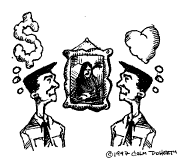![]()
![[ OPINIONS ]](/images/fall97/opinionsf97.gif)
![]()
By Brad Senning
Arizona Daily Wildcat October 14, 1997
De-commodifying art
![[Picture]](05_1_i.gif)
Brad Senning |
The folks in Assisi know how to love art. Victims of an ongoing earthquake,
their Basilica of St. Francis, with its frescoes by Giotto and Cimabue,
is crumbling. So the citizens are putting on their hair shirts and chanting
penitent submission to God.
Their beliefs are embodied proverbially: "No leaf moves if He doesn't want it to move." The earth, then, isn't merely a lettuce head with periodically shifting tectonic leaves; it's a stage where God's directions are implicit, yet every so often a certain performer is gaffing his lines and God needs to send a firm reminder. In this analogy the reminder is an earthquake and the gaffer is Assisi. The citizens understand. They want to make good with God.
Here in the United States, removed by a huge sea and a different cultural identity, we can relate to Italy's damage only by its cash value. Our take on tragedy has been formed by California disaster news coverage, which always comprehends the extent of destruction by the cost of rebuilding. We see the president floating billion-dollar checks and insurance companies assessing damages with blue books in their hands. But we know enough not to keep too much of our nation's art in California. Art is one of those irreplaceable things we'd rather not store too close to a protean disaster zone.
Pollack is dead, de Kooning more recently lost, and Lichtenstein died just the other day. The moving finger having writ and passed, we cannot invite these momentous artists back to restore what might be damaged by the sledge of nature. Our empathy for Italy is apparent in such veneration of their art as "priceless" and "irreplaceable." Yet our heart-felt response is only checked by the minuteness of our attention.
I open the Newsweek dated Oct. 6. I flip forward, looking for a Diana-sized layout, pictures of the damaged Basilica, the history of Assisi and repercussions of this great loss to the art world. Instead, I find two pictures the size of business-cards with a two-sentence caption. No story. The header of the photos says "Tragedy in Assisi." The caption says "priceless frescoes." Somewhere below the account of Basilica damage: "At least 10 people ... were killed."
Before I was here studying literature and writing insipid diatribes about cultural rot, I was working in management at Sears, Roebucks. On an especially humid day in Silver Springs, Md., where we young managers were being taught the art of power lunches, I stumbled into an absurd moment of deep reflection. I recalled thumbing through the textbook of my required college history course. There was a black-and-white photo of a remarkable stone statue. It had been reclaimed from some archaeological dig of some ancient society. The caption below the picture read, parenthetically, that the statue had since been destroyed in warfare. I mentioned this to one of my colleagues. "I can see the statistics of death in war without flinching, but artwork is our connection to the past. It's destruction disturbs our sense of human history." To which he made a wet sucking sound to remove any excess loads of rib fat from his teeth and said, "Shit happens."
Art has historically reflected its culture's appreciation. The beauty of Hellenic art is depicted in tales of men leaping into the embrace of a marble Aphrodite statue. Some cultures prized art as furniture to display in their homes. Some used art to monumentalize triumphant battles. Our culture prefers to value art as an investment, as a commodity.
In 1995, an ordinary statue decorating a courtyard of New York's French Embassy was transformed - Pygmalion-like - into a pricey masterpiece. It took one art historian to "discover" it was a Michelangelo and several news sources to tout the discovery. Before long, the Metropolitan Museum of Art wanted to show it and people were flabbergasted that it had stood for so long within the grasp of so many ignoble human mitts.

What do aesthetics matter? One moment it's a beautiful piece of art; the next moment it's a beautiful piece of art worth millions! Can we look at Van Gogh's Irises and appreciate the artistic quality more than its $53.9 million cash value?
Our media's lack of interest in the collapse of the Basilica of St. Francis is for the very reason that it is "priceless." No auction house could conceive a starting bid. No insurance assessor could find Giotto in his blue book. What is news without numbers? What, exactly, is the monetary quantity of "priceless," please?
I was standing in front of Grant Wood's "American Gothic" in Chicago two summers ago when a boy only old enough to know what to idolize went bounding forward. "This painting is so famous!" he said, his mouth agape with something like awe. I realized he wasn't looking at a painting. He was looking at a Michael Jordan. He was seeing a commodified emblem of our culture.
We can sit in front of a Matisse for hours without knowing the auction value. We can be disoriented by the specks of a Seurat or the Ben Day dots of a Lichtenstein without knowing who they really were, or why they were doing this. The people of Assisi may seem to appreciate the Basilica with an irrational sense of religious faith, but some things should remain irrational. As we humans can love without reason, so we can cherish art pricelessly.
Brad Senning is a senior majoring in American literature and creative writing.



